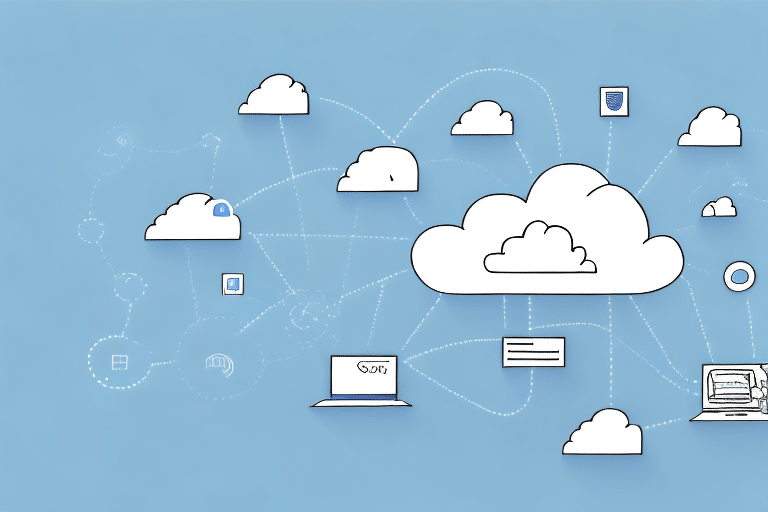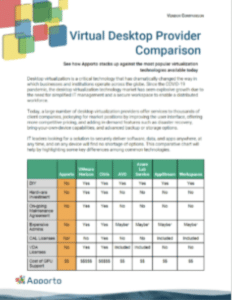What is VDI as a Service?
Virtual Desktop Infrastructure (VDI) has been used for years to deliver desktops to users in a secure and efficient manner. VDI as a Service (VDIaaS) takes the benefits of traditional VDI and delivers them in a cloud-based experience. This article aims to explore what VDIaaS is, its advantages, implementation strategies, and management tools.
Understanding VDI
Virtual Desktop Infrastructure (VDI) is a technology that has revolutionized the way organizations provide desktop environments to their users. By hosting desktop operating systems on a central server, VDI enables a more managed and secure environment for end-users. This technology has become increasingly popular in recent years, as more and more organizations are looking for ways to improve their desktop management and provide remote access to their employees.
What is Virtual Desktop Infrastructure (VDI)?
VDI is a virtualization technology that enables organizations to host desktop operating systems on a central server. This server then delivers the desktop environments to end-users over the network. This technology enables organizations to provide a more secure and managed desktop environment to their users, while also enabling remote access to desktops for employees that work from home or on the go.
The process of delivering desktop environments to end-users using VDI involves several components. These include:
- A central server that hosts the desktop operating systems
- A hypervisor that enables multiple desktop environments to run on the central server
- A connection broker that manages the delivery of desktop environments to end-users
- A network protocol that enables the delivery of desktop environments over the network
Benefits of VDI
There are several benefits to using VDI, including:
- Improved security and data protection: By hosting desktop operating systems on a central server, organizations can better protect their data and prevent unauthorized access to their systems.
- Easier desktop management and maintenance: With VDI, organizations can more easily manage and maintain their desktop environments, reducing the time and effort required to keep their systems up to date.
- Centralized access to corporate applications and data: VDI enables end-users to access corporate applications and data from a centralized location, improving productivity and collaboration.
- Remote access to desktops for employees working from home or on the go: VDI enables employees to access their desktop environments from anywhere, using any device with an internet connection.
Common VDI Use Cases
VDI can be used in a variety of scenarios, including:
- Delivering a secure and managed desktop environment to employees: VDI enables organizations to provide a more secure and managed desktop environment to their employees, reducing the risk of data breaches and other security incidents.
- Providing virtual desktops to contractors and partners: VDI can be used to provide virtual desktops to contractors and partners, enabling them to access corporate applications and data without requiring access to the organization’s physical systems.
- Managing desktop environments for Bring Your Own Device (BYOD) initiatives: VDI can be used to manage desktop environments for BYOD initiatives, enabling employees to access their desktop environments from their personal devices.
Overall, VDI is a powerful technology that enables organizations to provide a more secure, managed, and flexible desktop environment to their users. Whether you are looking to improve your desktop management, provide remote access to your employees, or enhance your security and data protection, VDI is a technology that is worth considering.
VDI as a Service: An Overview
Virtual Desktop Infrastructure as a Service (VDIaaS) is a cloud-based service that delivers the benefits of traditional VDI in a scalable and cost-effective manner. With VDIaaS, desktops are hosted in a cloud environment and delivered to end-users over the internet.
VDIaaS is a relatively new technology that has emerged as a response to the growing need for remote work and the increasing demand for cloud-based solutions. With VDIaaS, businesses can provide their employees with secure, remote access to their work desktops from any device, anywhere in the world.
Traditional VDI vs. VDI as a Service
The traditional VDI approach involves purchasing and maintaining the server infrastructure needed to support desktop virtualization. This can be costly and time-consuming, as it requires businesses to invest in expensive hardware, software, and IT staff to manage the infrastructure.
With VDIaaS, the server infrastructure is taken care of by the service provider, reducing the upfront cost and complexity of the implementation while allowing for scalability and redundancy. This means that businesses can focus on their core operations and leave the IT infrastructure to the experts.
Key Components of VDI as a Service
VDIaaS consists of several key components that work together to deliver a seamless virtual desktop experience:
- Cloud-based servers: These servers host the virtual desktops and are responsible for running the necessary software and applications.
- Networking infrastructure: This infrastructure delivers the virtual desktops to end-users over the internet. It ensures that the virtual desktops are delivered quickly and securely.
- Storage infrastructure: This infrastructure is responsible for storing the desktop images, user data, and applications. It ensures that the virtual desktops are always available and accessible.
- Management consoles: These consoles provide administrators with the tools they need to manage and monitor the virtual desktop environment. They allow administrators to add or remove users, allocate resources, and troubleshoot issues.
Advantages of VDI as a Service
VDIaaS offers several advantages over traditional VDI:
- Reduced upfront costs: With VDIaaS, businesses do not need to invest in expensive hardware or software. Instead, they pay a monthly fee for the service, which is typically lower than the cost of purchasing and maintaining their own infrastructure.
- Scalability and flexibility: VDIaaS allows businesses to scale their virtual desktop environment up or down based on their changing needs. They can add or remove users, allocate resources, and adjust their service level agreement (SLA) as needed.
- Improved availability and redundancy: VDIaaS providers typically offer high availability and redundancy, which means that businesses can be confident that their virtual desktops will be available when they need them.
- Predictable costs and simplified billing: With VDIaaS, businesses pay a predictable monthly fee for the service, which makes budgeting and forecasting easier. Additionally, they receive a single bill for all of their virtual desktop services, which simplifies the billing process.
Overall, VDIaaS is a powerful solution for businesses that want to provide their employees with secure, remote access to their work desktops. With its scalability, flexibility, and cost-effectiveness, VDIaaS is quickly becoming the go-to solution for businesses that want to stay competitive in today’s rapidly changing business landscape.
Implementing VDI as a Service
Virtual Desktop Infrastructure as a Service (VDIaaS) is a cloud-based solution that enables businesses to deliver virtual desktops to end-users over the internet. VDIaaS offers several benefits, such as increased flexibility, scalability, and cost-effectiveness. However, implementing VDIaaS requires careful planning and execution to ensure a successful deployment.
Choosing the Right VDI as a Service Provider
Choosing the right VDIaaS provider is critical to the success of your implementation. When selecting a provider, consider the following:
- Experience in delivering desktops in a cloud environment: Look for a provider with a proven track record of delivering desktops in a cloud environment. Check customer references and case studies to ensure that the provider has successfully implemented VDIaaS for businesses similar to yours.
- Security and compliance capabilities: Ensure that the provider has robust security and compliance capabilities to protect your data and meet regulatory requirements.
- Scalability and availability features: Choose a provider that can scale to meet your business needs and provide high availability and redundancy. Look for features such as load balancing, auto-scaling, and geographic redundancy.
- Cost-effectiveness and service-level agreements (SLAs): Evaluate the provider’s pricing model and SLAs to ensure that they align with your business requirements. Look for flexible pricing models, such as pay-per-use or subscription-based, and SLAs that guarantee high availability and performance.
Deployment Process and Best Practices
Deploying VDIaaS involves several steps, and following best practices can help ensure a successful implementation:
- Assess and plan for infrastructure requirements: Before deploying VDIaaS, assess your infrastructure requirements, including compute, storage, and network resources. Ensure that your infrastructure can support the expected workload and performance requirements.
- Design and configure virtual desktop images and applications: Design and configure virtual desktop images and applications based on your business requirements. Consider factors such as user profiles, applications, and data storage requirements.
- Configure networking and security features: Configure networking and security features, such as firewalls, VPNs, and encryption, to protect your data and ensure secure remote access to virtual desktops.
- Test and pilot the virtual desktop environment: Test and pilot the virtual desktop environment to ensure that it meets your performance and usability requirements. Conduct user acceptance testing (UAT) and collect feedback to refine the environment.
- Migrate users to the new environment: Migrate users to the new environment in a phased approach to minimize disruption and ensure a smooth transition. Provide training and support to users to ensure a successful migration.
- Monitor and optimize the environment for performance and availability: Monitor the environment for performance and availability issues, and optimize it as needed to ensure optimal user experience and minimize downtime.
Ensuring Security and Compliance
Security and compliance are critical in VDIaaS implementations, and following best practices can help ensure a secure and compliant environment:
- Set up secure remote access protocols: Set up secure remote access protocols, such as SSL VPN or IPsec, to protect data in transit and prevent unauthorized access to virtual desktops.
- Ensure proper access controls and authentication mechanisms are in place: Ensure that proper access controls and authentication mechanisms, such as two-factor authentication and role-based access control, are in place to prevent unauthorized access to virtual desktops and data.
- Monitor for potential security threats and vulnerabilities in the environment: Monitor the environment for potential security threats and vulnerabilities, such as malware and unauthorized access attempts, and take appropriate measures to mitigate them.
- Perform regular security and compliance audits: Perform regular security and compliance audits to ensure that the environment meets regulatory requirements and industry standards.
In conclusion, implementing VDIaaS requires careful planning and execution to ensure a successful deployment. Choosing the right provider, following best practices, and ensuring security and compliance are critical to the success of your implementation.
Managing and Scaling VDI as a Service
Managing and scaling VDIaaS involves the following:
Monitoring and Performance Management
Monitoring and managing VDIaaS performance is essential to ensure a good end-user experience. This includes:
- Monitoring network and storage bandwidth usage and optimizing as needed
- Proactively monitoring for potential issues with desktops or applications
- Providing end-users with a user-friendly helpdesk and support experience
Troubleshooting Common Issues
VDIaaS implementations may face common issues such as poor end-user experience, application compatibility, and network connectivity. Having effective troubleshooting procedures in place is essential to minimize downtime and maintain productivity.
Scaling Your VDI as a Service Environment
Scalability and flexibility are key benefits of VDIaaS. When scaling your VDIaaS environment, consider the following:
- Managing compute, network, and storage resources efficiently
- Maintaining consistency and standardization across the environment for ease of management
- Automating infrastructure provisioning and management tasks
- Providing ongoing user education and support services to maximize adoption and productivity
Conclusion
VDI as a Service, or VDIaaS, is a powerful and flexible cloud-based solution for delivering virtual desktops and managing desktop environments. It offers many advantages over traditional VDI, including reduced upfront costs, scalability, redundancy, and flexibility. By following best practices for deployment, management, and scaling, businesses can maximize the benefits of VDIaaS and provide a strong, secure, and productive desktop environment for their end-users.



